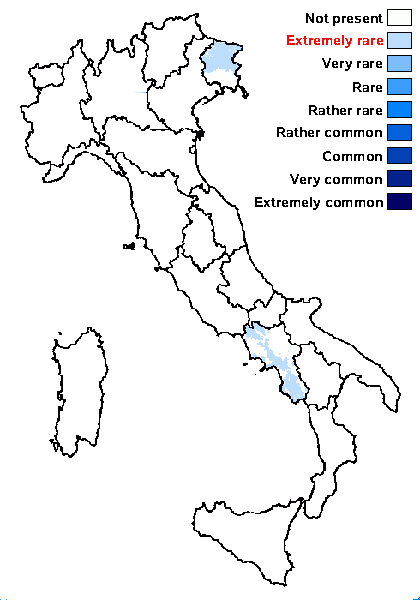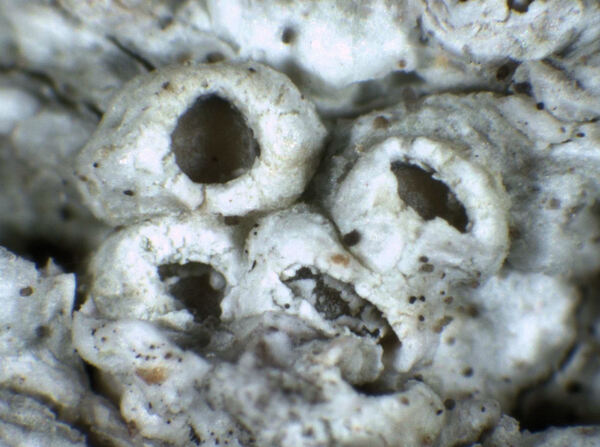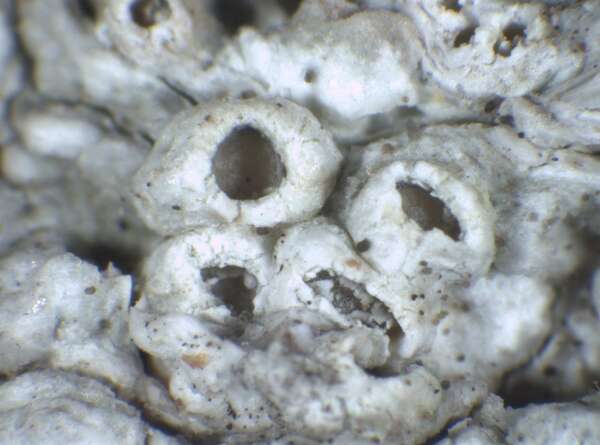Thelotrema suecicum (H. Magn.) P. James
Lichenologist, 9: 186, 1977. Basionym: Ocellularia suecica H. Magn. - Bot. Not.: 125, 1937.
Synonyms:
Distribution: N - Frl (Tretiach 2004). S - Camp (Ravera & al. 2016).
Description: Thallus crustose, endo- to thinly episubstratic, pale yellowish grey to pale greyish green, smooth, continuous to verruculose or finely rimose. Medulla white, densely packed with crystals of calcium oxalate. Apothecia usually numerous, evenly distributed, deeply immersed in prominent, conical thalline warts which are 1-2 mm wide at the base, and have an open, up to 0.4 mm wide, crater-like summit with an irregular rim, the disc to 0.7 mm across, blackish or grey-pruinose, surrounded by a prominent proper margin which is usually free from the thalline margin. Proper exciple thin, brownish to yellowish in outer part, colourless to very pale yellow within, apically covered by greyish granules, of densely conglutinated, short-celled hyphae; epithecium colourless to brownish, with greyish granules; hymenium colourless, up to c. 130 µm high, not inspersed with oil droplets; paraphyses weakly conglutinated, mostly simple, thickened at apex; periphysoids present, lining the upper inner surface of the exciple; hypothecium colourless. Asci (2-)4-6(-8)-spored, subcylindrical, with a single functional wall layer, abruptly thickened at apex, K/I-. Ascospores (3-)5-7-septate, hyaline, ellipsoid to broadly fusiform, the ends narrowly rounded to subacute, non-amyloid to faintly amyloid, 20-35(-40) x 8-12(-15) µm, with 4-6(-8), rounded to angular, subglobose or cuboid cells, surrounded by a thin to thick halo. Photobiont trentepohlioid. Spot tests: K-, C-, KC-, P-, UV-. Chemistry: without lichen substances.Note: a very rarely collected, mainly western species also known from the Austrian Alps, found on bark in montane, humid forests. It is included in the Italian red list of epiphytic lichens as “Endangered” (Nascimbene & al. 2013c).
Growth form: Crustose
Substrata: bark
Photobiont: Trentepohlia
Reproductive strategy: mainly sexual
Most common in areas with a humid-warm climate (e.g. most of Tyrrenian Italy)
Commonnes-rarity: (info)
Alpine belt: absent
Subalpine belt: absent
Oromediterranean belt: absent
Montane belt: extremely rare
Submediterranean belt: absent
Padanian area: absent
Humid submediterranean belt: extremely rare
Humid mediterranean belt: absent
Dry mediterranean belt: absent

Predictive model
Growth form: Crustose
Substrata: bark
Photobiont: Trentepohlia
Reproductive strategy: mainly sexual
Most common in areas with a humid-warm climate (e.g. most of Tyrrenian Italy)
Commonnes-rarity: (info)
Alpine belt: absent
Subalpine belt: absent
Oromediterranean belt: absent
Montane belt: extremely rare
Submediterranean belt: absent
Padanian area: absent
Humid submediterranean belt: extremely rare
Humid mediterranean belt: absent
Dry mediterranean belt: absent

Predictive model
 Index Fungorum
Index Fungorum
 GBIF
GBIF





